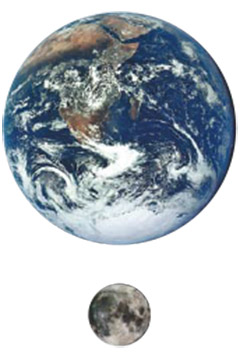You are here
Scale Models
Grade Level: Grades 6-8 (Ages 11-13)
Subject Areas: Science
 Without being informed of the expected product, the students will make a Play-doh model of the Earth-Moon system, scaled to size and distance. The facilitator will reveal the true identity of the system at the conclusion of the activity. During the construction phase, students try to guess what members of the solar system their model represents. Each group receives different amounts of Play-doh, with each group assigned a color (red, blue, yellow, white). At the end, groups set up their models and inspect the models of other groups. They report patterns of scale that they notice; as the amount of Play-doh increases, for example, so do the size and distance of the model.
Without being informed of the expected product, the students will make a Play-doh model of the Earth-Moon system, scaled to size and distance. The facilitator will reveal the true identity of the system at the conclusion of the activity. During the construction phase, students try to guess what members of the solar system their model represents. Each group receives different amounts of Play-doh, with each group assigned a color (red, blue, yellow, white). At the end, groups set up their models and inspect the models of other groups. They report patterns of scale that they notice; as the amount of Play-doh increases, for example, so do the size and distance of the model.
Materials
On a central table for all to share
- String
- Rulers or meter sticks • Scissors (optional)
For each group
- One or more cans of Play-doh. All the Play-doh for a group should be the same color.
- Large paper sheet as a work surface for rolling and shaping the Play-doh
Preparation
Color code each amount of Play-doh: red, 2 cans; blue, 1.5 cans; yellow, 1 can; white, 0.5 can. Divide students into groups of two to four members. Lay out materials for all groups to share in a central location. Distribute Play-doh and one large piece of paper to each group.
Activity
Introduce the problem
Tell the groups that they will make a scale model of two members of our solar system. Do not reveal that it is the Earth and Moon — that’s the surprise that makes this activity memorable. Along the way, they can make guesses about what the model represents.
Divide the Play-doh
Tell groups to divide their Play-doh into five equal pieces.
They may use whatever creative and clever means they can think of to solve this problem. Example solution: Roll the Play-doh into a long cylinder, then divide it into pieces. A 50-cm cylinder can be cut into 10-cm lengths, then formed into spheres. Tell groups to divide up one of the larg- er pieces into 10 equal size pieces; set one of these smaller pieces aside.
Create two carefully sized pieces
Tell each group to mash everything together (except the one small piece previously set aside) into one big sphere. Roll the remaining small piece into a little sphere.
Make a guess
After they have made two Play-doh spheres, ask each group to write down three guesses about what these solar system objects might represent. Discuss the guesses with the students. At least one student will guess they are Earth and the Moon. Next, ask them to make a guess of how far apart to put their Earth and Moon spheres to make a true model. A scientist follows up and tests guesses with observations and measurements.
Measure the big sphere diameter; this is the diameter of Earth
Tell each group to measure the diameter of the Earth sphere. They may cut the sphere in half. They may measure with a string and mark off the diameter or use a meter stick.
Separate the big and little spheres
After students have measured the Earth and Moon sphere diameters, ask each group to place the big and little spheres apart by 30 Earth-sphere diameters. Groups with the least Play-doh will probably be able to lay out their models on the table top. The two-can group might have to lay out its model on the floor.
Inspect other models, compare, and analyze
After all the groups have laid out their models, ask everyone to inspect other groups’ models. Discuss the results. Models will differ in three main ways, besides the color of the Play-doh: the relative sizes of the Earth spheres, the relative sizes of the Moon spheres, and the distance between the spheres. But all of these differences are related to the same set of pro- portions. The ratios of Earth diameter:Moon diameter and Earth diameter: separation distance are the same for each model.
Extend
The Sun is about 150 million km from Earth. Estimate how many Earth diameters and Earth-Moon distances in your system would be needed to put the Sun in your model. Compare the sizes of the Sun and the Moon’s orbit around Earth.
Background
| Earth | Moon | Ratio | |
|---|---|---|---|
| Diameter (km) | 12,756 | 3,475 | 3.7 |
| Volume (m3) | 1.08 x 1021 | 2.2 x 1019 | 49 |
Since spherical volume is 4/3  Πr3, the ratio of Earth-to-Moon volume is 49.5. The mean separation between Earth and the Moon is 384,500 km. So the ratio of the Earth-Moon separation to Earth’s diameter is:
384,500 km ÷ 12,756 km = 30 Earth diameters
In round numbers, Earth’s volume is 50 times that of the Moon, and the Moon is about 30 Earth diameters away. The Sun is 11,759 Earth diameters, or 390 Earth-Moon distances away from Earth. The diameter of the Moon’s orbit is twice the Earth-Moon distance (384,500 km x 2 = 769,000 km); the diameter of the Sun is 1,392,000 km. The Moon’s orbital path around Earth is about half the diameter of the Sun.



